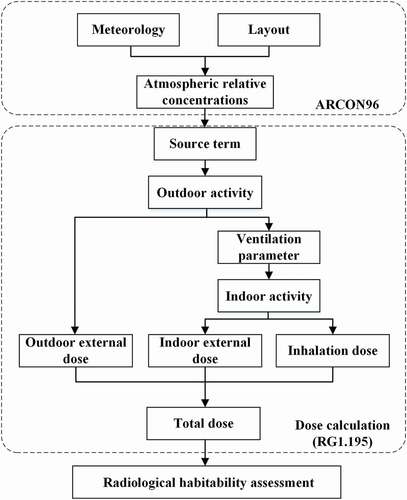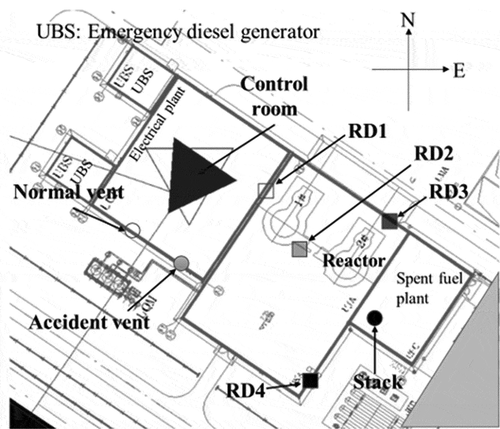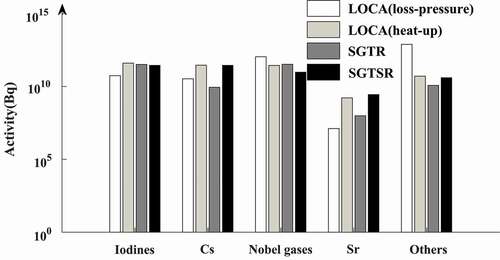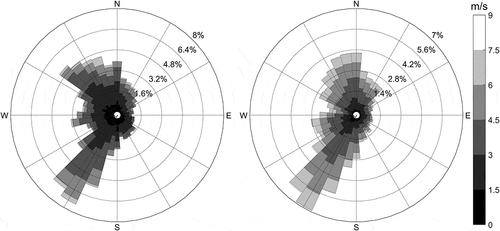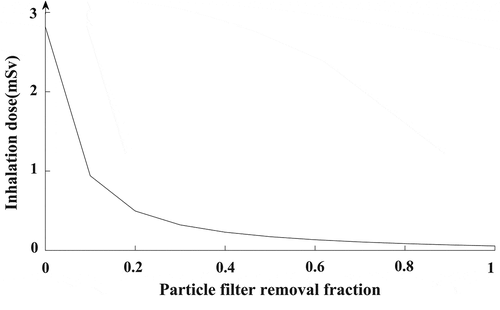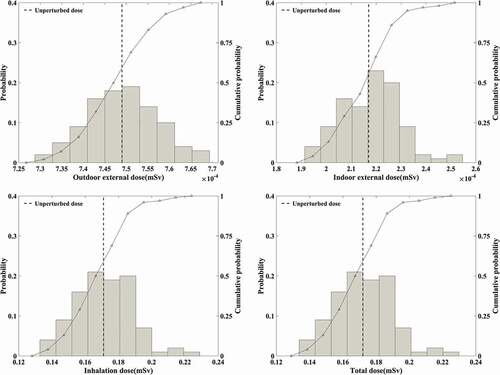 ?Mathematical formulae have been encoded as MathML and are displayed in this HTML version using MathJax in order to improve their display. Uncheck the box to turn MathJax off. This feature requires Javascript. Click on a formula to zoom.
?Mathematical formulae have been encoded as MathML and are displayed in this HTML version using MathJax in order to improve their display. Uncheck the box to turn MathJax off. This feature requires Javascript. Click on a formula to zoom.ABSTRACT
The radiological habitability of a control room is important for nuclear emergency response, which is also a licensing prerequisite for nuclear power plants. It is determined by both atmospheric relative concentrations and doses received via different pathways. However, most recent studies have focused only on the former, which may not be adequate. The present study therefore investigates the radiological habitability and its sensitivity to different parameters in the high-temperature gas-cooled reactor pebble-bed module power plant. For three typical accidents, the study estimates the body, thyroid and skin doses received via different pathways using the Nuclear Regulatory Commission recommended ARCON96 and dose calculation method in RG 1.195. To make a realistic evaluation, the latest design and site-specific information, including the unique accidental source term, are collected and used as input parameters. The evaluation results reveal that the total dose of different pathways in the control room is far below the limit, which demonstrates the effectiveness of the current design. The inhalation exposure is the dominant pathway, and iodine and caesium are the primary contributors of the inhalation dose. The particle filter removal fraction is the most influential parameter in an accident which the activities of metal radionuclides are high.
1. Introduction
The radiological habitability of a control room (CR) is important for staff safety and a successful emergency response in nuclear accident scenarios, and is an essential target of nuclear power plant design. The habitability is assessed by calculating the atmospheric relative concentrations (ARCs) in the vicinity of buildings and the corresponding individual dose received via different pathways. Most recent research on CRs has focused on calculation models of ARCs near buildings, including the earlier Murphy–Campe model [Citation1], the new building wake model, the composite wake model [Citation2], the RG 1.145 model [Citation3] and the Atmospheric Release CONcentrations in the building wakes computer code (ARCON95) [Citation4]. ARCON96 was developed from ARCON95 to meet standards [Citation5].
Among the above models, ARCON96 uses tailored dispersion coefficients to account for low-wind-speed meander and building wake effects, and has been validated in seven field experiments conducted at different nuclear power plant sites with the release position of the source next to buildings. According to the validation results, 84.2% of ARCON96 predictions were within a factor of 10 of the measurements, and ARCON96 outperformed the Murphy–Campe model (59.1%) and RG 1.145 model (61.7%) [Citation6]. ARCON96 has been also compared with the MELCOR Accident Consequence Code System, Version 2 (MACCS2) to the WAKE portion of the HGSYSTEM/UF6 model for validation, which represents the state of the science in the modeling of dispersion in building wakes [Citation7]. The results of the comparison study show that ARCON96 handles the plume meander at low wind speeds better than MACCS2. Recently, both first- and second-order systematical sensitivity studies were performed using ARCON96 for ground-level release calculations, showing that ARCON96 is robust in short-range air dispersion prediction [Citation8]. These studies demonstrate the feasibility of using ARCON96 in the calculation of ARCs near buildings, especially for nuclear power plants.
The major limitation of ARCON96 is that it does not consider buoyant releases, jet releases with initial upward momentum, heavy gases, chemical reactions, or radionuclide deposition [Citation7]. Additionally, RG 1.194 points out that the vent release calculation of ARCON96 is not conservative, and it is thus recommended to replace the vent release calculation with the ground-level or stack release calculation in practice. To correctly handle these limitations, RG 1.194 presents detailed guidelines on the use of ARCON96 [Citation9]. Following these guidelines, ARCON96 has been successfully applied to the calculation of ARCs for different nuclear power plant sites with various types of reactor, such as in the building design evaluation of the Wolsung nuclear site in Korea [Citation10], safety and consequence analyses for the Yucca Mountain project [Citation7].
However, most of the above research focused on the air dispersion calculation, while the radiological habitability of a CR is determined by multiple parameters instead of the ARCs alone. Therefore, a set of satisfactory ARCs does not necessarily indicate the acceptable radiological habitability of a CR. Compared with focusing on ARCs, it might be more appropriate to perform a complete dose analysis for radiological habitability assessment of a CR. Meanwhile, a comprehensive sensitivity investigation that is based on a complete dose analysis would be worthwhile in revealing the site-specific dominant parameters for the radiological habitability assessment of a CR. Unfortunately, there have been few reports on these two aspects as far as we know.
The present study performs a complete dose assessment and a comprehensive sensitivity analysis for the CR of the high-temperature gas-cooled reactor-pebble bed module (HTR-PM), using ARCON96 and the dose calculation method in RG 1.195. The assessment includes three typical accident scenarios of HTR-PM, in which different source terms, exposure pathways and organs or tissues are considered. To make a realistic evaluation, the latest design and site-specific information, including the unique accidental source term of HTR-PM, the release and ventilation parameters, the final layout and the 1-year meteorological data of the site, are collected and used as input parameters. The sensitivity of the control room habitability (CRH) to single and multiple parameters is analyzed to reveal the dominant parameters. The robustness of the dose estimation is evaluated via multi-parameter sensitivity analysis using the Monte Carlo Method (MCM).
2. Method
schematically displays the radionuclide transport process and exposure pathways in an accident scenario. The radionuclides are released into the environment via the rupture disc (RD) or the stack, depending on the accident. The released radionuclides disperse away in the atmosphere. Because the CR is isolated from the outdoor environment with shielding walls and has an independent food/water supply, the only way the released radionuclides can enter the CR is through the accident vent of the ventilation system (). The operators stay in the CR and do not leave in the accident scenarios, so they take the radiation exposure in the CR only. Specifically, there are three exposures pathways (indicated by the wavy arrows in ), including the external irradiation from the outdoor radionuclides, the external irradiation from the entering radionuclides inside the CR and the inhalation irradiation from the radionuclides that are taken inside the operators through their breath. The three pathways are consistent with recommendations made in Chinese Standards [Citation11] and RG 1.195.
Figure 1. The transport process of radionuclides and three different exposure pathways: the dotted arrows indicate the process that radionuclides enter environment and CR, and the wavy arrows represent the outdoor/indoor external irradiation and inhalation irradiation.
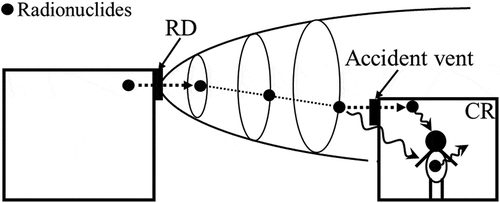
Based on the above scenario, the assessment of the radiological habitability of the CR can be summarized into two major parts (). The first part is the calculation of the ARCs using ARCON96. Ground release settings are used in all ARCON96 calculations following the guidelines in RG 1.194.
The second part is the dose calculation of different exposure pathways. In the dose calculation, the outdoor and indoor activities are first computed using the ARCON96-calculated ARCs and the design parameters of the ventilation system (RG 1.195). The doses of the three pathways are then assessed using these activities and corresponding dose conversion factors (DCFs) of the body, thyroid, and skin [Citation12,Citation13].
2.1. ARCON96 model
ARCON96 uses hourly meteorological data and geographical data to calculate ARCs for periods ranging from 2 h to 30 days. ARCON96 is based on the straight-line Gaussian model, which assumes a constant release during the period of calculation. For a ground-level release, the straight-line Gaussian model can be expressed as [Citation4]
where is the ARC (i.e., the concentration divided by the release rate, s/m3).
and
are diffusion coefficients (m), which are computed using the Pasquill–Gifford formula in this study. U is the wind speed (m/s) and the direction of U is considered as x-direction. y is the distance from the axis of the plume (m).
To account for the low wind speed and building wake, ARCON96 uses a set of composite wake diffusion coefficients that can be formulated as
where and
are respectively horizontal and vertical corrections for low wind speed, and
and
are respectively horizontal and vertical corrections for the building wake.
Before computing EquationEquation 1(1)
(1) , ARCON96 examines the hourly meteorological data and filters out those data that are too far from the downwind direction. For each of the remaining meteorological data, calculations are made using EquationEqutions 1
(1)
(1) and Equation2
(2)
(2) and the corrected diffusion coefficients to obtain a set of ARCs. The 95 percentile value of this data set is selected as the most representative value, and is later used in the assessment of CRH.
2.2. Dose calculation for different pathways
Three pathways are considered in assessing the occupational exposure for radiological habitability assessment of the CR, as suggested by RG 1.195 [Citation9].
2.2.1 Outdoor external dose from the outdoor radioactive plume
The outdoor activity of the radionuclides at the calculation position is formulated as
where aaout is the outdoor activity of the radionuclides at the calculation position (Bq), Qki is the emission amount of radionuclide i in release period k (Bq) and is the ARC at the calculation position for release period k (s/m3), which is given by ARCON96.
With outdoor activity aaout, the dose due to the external irradiation can be calculated as
where Daout is the effective dose from cloud immersion at the calculation position (Sv) and DFai is the effective DCF of cloud immersion for radionuclide i ((Sv/s)/(Bq/m3)). Rwall is the dose reduction factor relating to the shielding effect of the 50-cm-thick wall of the CR.
The present study calculates Rwall using a single-energy linear-decay formula. To be conservative, the γ-ray energy for all three accidents is chosen to be 1.25 MeV, which is higher than the average γ-ray energies of the three accidents (0.559, 0.476, and 0.667 MeV). The dose reduction factor is calculated to be 1/150 for the 1.25-MeV γ-ray energy and 50-cm-thick concrete wall [Citation14].
2.2.2 Indoor external dose from indoor radioactive air immersion
The activities of radionuclides that are transported to the CR via only atmospheric dispersion can be modeled using the equation
where ai is the activity of radionuclide i in the CR (Bq), QerF is the filtered intake flow rate from the environment to the CR (m3/s), QerU is the unfiltered intake flow rate from the environment to the CR (m3/s), fer is the filter removal fraction for a filter between the environment and CR (dimensionless), S is the release rate of the radionuclide (Bq/s) and is the removal coefficient of the i-th radionuclide in the j-th removal process. In this research, the removal process consists of three parts: the gas leak from CR to the environment, the radioactive decay and the removal in the recirculation. The corresponding removal coefficients are: (1) exhaust rate from the CR to the environment (s−1):
, where Lair is the gas leak flow from CR to the environment (m3/s), V is the free volume of CR (m3); (2) nuclide decay constant (s−1); (3) recirculation removal rate (s−1):
, where
is the recirculation flow rate in CR (m3/s),
is the recirculation filter removal fraction, dimensionless.
For each period, the integrated activity of all radionuclides in the CR is calculated as
where IAik is the integrated activity of radionuclide i in the CR in period k (Bq⋅s) and tk0 and tk1 are respectively the start and end times of period k.
With the integrated activity, the external dose from indoor radioactive air immersion can be calculated as
where Dain is the indoor external dose due to immersion in the indoor radioactive air (Sv). is the geometry correction factor (dimensionless) that accounts for the effect of the CR’s volume and converts semi-infinite gamma dose to a finite dose in Murphy’s method [Citation1]. DFai is the effective DCF of cloud immersion for radionuclide i ((Sv/s)/(Bq/m3)). And Ok is the occupancy factor, which is the proportion of a day that the staffs stay in the CR during time interval k (dimensionless) [Citation9].
2.2.3 Inhalation dose from the inhalation of radioactive air
The inhalation dose is calculated using the integrated activity, with consideration of the respiration rate. The specific formula is
where Dhin is the inhalation dose of an individual in the CR (Sv), DFhi is the inhalation irradiation DCF for radionuclide i (Sv/Bq) and Br is the respiration rate (m3/s).
2.2.4 Total dose
Finally, the total dose received by an individual in the CR during an accident is the sum of the doses of the aforementioned pathways:
The total dose D is then compared with the limit in regulations to assess the radiological habitability of the CR in an accident [Citation11].
3. Numerical experiment
3.1. CR design and plant layout
China’s HTR-PM is currently in the stage of construction and final safety analysis [Citation15]. The layout of the buildings around the CR of HTR-PM is shown in . The CR is located inside the electrical plant of HTR-PM, and is to the northwest of the reactor building. The ventilation system of the CR is equipped with two air inlet vents. One vent works only during normal operation while the other works only in an accident. Both vents are on the southwest wall of the electrical plant (as indicated by small circles ![]() and
and ![]() in ).
in ).
There are four RDs (which rupture when pressure changes by more than 7.9 MPa) in the HTR-PM buildings. Three (RD1, RD3, and RD4 as indicated by the small squares ![]() ,
, ![]() and
and ![]() ) are on the north-western, eastern and southern walls of the reactor building. The fourth (RD2 as indicated by the small square
) are on the north-western, eastern and southern walls of the reactor building. The fourth (RD2 as indicated by the small square ![]() ) is on the reactor building. In an accident, the four RDs are all possible sites of atmospheric radionuclide release, depending on the specific process of an accident. The stack (as indicated by the small circle
) is on the reactor building. In an accident, the four RDs are all possible sites of atmospheric radionuclide release, depending on the specific process of an accident. The stack (as indicated by the small circle ![]() in ) is located in the spent-fuel storage building.
in ) is located in the spent-fuel storage building.
3.2. Accident scenario and source term
To make an assessment that envelops accident scenarios of HTR-PM, three typical accident scenarios and corresponding source terms are selected for the assessment of CRH. These scenarios include two most severe design-basis accidents, namely a large-break loss of coolant accident (LOCA) and a steam-generator tube rupture accident (SGTR), and a beyond design basis accident, namely a steam-generator tube-sheet rupture accident (SGTSR) [Citation16,Citation17]. KORIGEN code is used in calculating the source terms [Citation18].
For the LOCA, there are two stages of radioactive releases. In the first 2 h, pressure is released through an RD along with the radionuclides. Radionuclides are released through the stack for the remainder of the release. The ARCs and dose rates were calculated respectively for these two stages, and then summed together, so as to be conservative.
For the SGTR and SGTSR, all radionuclides are released via an RD within 0–2 h, and there is no release after 2 h. compares the species of radionuclides released in the three accident scenarios; the species are sorted into five categories.
3.3. Meteorology
The habitability assessment uses hourly meteorological data recorded at the Shidao Bay nuclear power plant in 2014. displays wind roses for the site, revealing that the local annual dominant wind direction is southwest at both measurement heights. The annual average wind speeds of the site at heights of 10 and 100 m are respectively 3.49 and 5.68 m/s.
3.4. Dose calculation and radiological habitability assessment
The parameters involved in the ARCON96 calculation are summarized in . For each accident, four ARCON96 calculations are performed, with the radionuclides released via different RDs in different calculations, to investigate the effect of the release position on the CRH.
Table 1. Calculation parameters of the atmospheric relative concentrations in an accident
Input parameters are listed in for dose calculations of different pathways. The parameters required for calculation of the inhalation dose, as recommended by RG 1.195, are listed in .
Table 2. Parameters of the dose calculation
Table 3. Parameters of the inhalation dose calculation
Although numerous radionuclides are released in each accident, the majority of the total dose received by the body, thyroid, and skin is dominated by only a few radionuclides. Therefore, the contribution of primary radionuclides to the inhalation dose of the body and thyroid is analyzed for each accident, to provide feedback for radiation protection.
3.5. Sensitivity analysis
3.5.1 Single- and multi-parameter sensitivity analyses
Both single- and multi-parameter sensitivity analyses are performed for the body dose calculation; the body dose is chosen because it is closest to the corresponding limit in regulation among the body, thyroid, and skin doses. The investigated parameters are (1) the volume flow of source, which is a parameter that can vary over a wide range in practice, (2) the filtered intake flow rate of the ventilation system, which may change considerably in practice because the working condition of the ventilation system is affected by various practical issues, (3) and the particle filter removal fraction of the ventilation system, which determines the activities of metal radionuclides that flow into the CR.
According to the physical process calculation and Chinese design standards [Citation19], the possible variation ranges are 0–75 m3/s for the volume flow of source (with a representative value being 7.70 m3/s), 900–1000 m3/h of the design value for the intake flow (with a representative value being 900 m3/h), and 0.4–0.6 for the particle filter removal fraction (with a representative value being 0.5). For the volume flow of source, it is more important to cover the lower bound than the upper bound, because the low volume flow of source causes high doses. To be conservative and ensure consistency among errors of different parameters, a standard deviation of 33.3% of the volume flow of source, 3.70% of the filtered intake flow rate, and 6.67% of the particle filter removal fraction is set as the magnitude of error added to corresponding parameter, so as to ensure coverage of the considered variation range at a 99.7% confidence interval.
MCM is used to simulate possible changes to the three parameters in practice, for the purpose of testing the corresponding sensitivity of the assessment to the three parameters. The sampling method used in this study is Latin hypercube. The sample size of the Monte Carlo simulation is 100.
The parameter settings in the MCM are summarized in . And the relative average deviation (RAD) and relative standard deviation (RSD) are used to quantify uncertainties in the simulation results:
Table 4. Parameter settings in Monte Carlo sensitivity analysis
where Di is the dose estimate of the i-th sample, D0 is the unperturbed dose and N is the number of samples.
3.5.2 Cumulative probability analyses
Cumulative probability sensitivity studies are conducted to demonstrate the robustness of the assessment in the case of the SGTSR; the SGTSR is chosen as it has the most severe consequence. The volume flow of source, the filtered intake flow rate and the particle filter removal fraction of the ventilation system are selected for investigation. The input uncertainties and their probability distribution functions are same as the multi-parameter analysis.
4. Results and discussion
4.1. CRH of the current design
4.1.1. Dose analysis and radiological habitability assessment
Body dose
As shown in the first row of , the inhalation dose makes the dominant contribution (exceeding 96.8%) to the total dose for all three accidents. There are two reasons for this phenomenon. First, some beta-emitting radionuclides, such as H-3 and C-14, do not contribute greatly to the external dose, owing to the poor penetrating ability of beta rays. However, these radionuclides are major contributors to the inhalation dose and their activities are comparable to or even higher than those of gamma-emitting radionuclides. Second, the calculated inhalation dose is the committed effective dose that considers a 50-year period of exposure according to the Chinese standard [Citation11]. The long integral period of the inhalation dose is unique, because the inhaled radionuclides can stay inside a person for a long time. In comparison, the external dose calculation only considers the period of the accident, because the external exposure stops once the radioactive plume is gone. In addition, the dose is highest when radionuclides are released via RD1, because it is the closest to the emergency inlet.
Figure 6. Dose distributions for four RDs releases and a stack release in three accidents; the label R1&S on the x-axis for the LOCA refers to RD1 release for 0–2 h and stack release after 2 h.
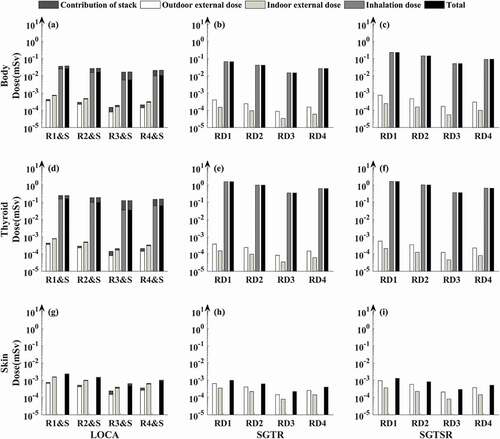
In the LOCA, the outdoor external dose is lower than the indoor external dose () because there is no shielding in indoor external dose calculation and the filter system does not remove noble gases, which are the majority of the LOCA source term. For the other two accidents, the outdoor external dose is higher than the indoor external dose because the majority of the source term is the iodines and metal radionuclides, the amounts of which are reduced by the filter system. Meanwhile, the stack release makes notable contributions to the doses of each pathway, and is 42–188% of the dose contributed by the RD release.
In the SGTR (), the total dose is slightly higher than that in the LOCA in RD1, RD2 and RD4 releases, owing to the greater iodine quantity in the source term. In the RD3 release, however, the total dose in the SGTR is lower than that in the LOCA because the stack release makes a large contribution that does not depend on the position of the RD.
In the SGTSR (), the total dose is at least three times the total doses in the other two accidents. The dose contribution of each pathway is similar to that in the SGTR. However, the inhalation dose is more dominant than that in the other two accidents, contributing 99.6% of the total dose, because there is much more Cs-134 and Cs-137 in the SGTSR source term and their DCFs are large.
Thyroid dose
The middle row of presents the thyroid dose in different accidents. The total dose of the thyroid in the SGTSR (1.62 mSv) is close to that in the SGTR (1.57 mSv) but the body doses in these two accidents differ obviously. The reason for the difference is that the inhalation irradiation DCF of I-131 for the thyroid dose is one order of magnitude larger than that for the body dose. Furthermore, I-131 is the dominant radionuclide in the SGTR. In addition, the contribution of the inhalation dose of the thyroid is larger than that of the body because the inhalation irradiation DCFs of many radionuclides (including iodines, Cs and Co) for the thyroid are larger than those for the body.
Skin dose
Unlike the cases of body and thyroid doses, inhalation does not contribute to the skin dose. Meanwhile, the outdoor external and indoor external doses of skin are larger than that of body and thyroid due to the external irradiation DCFs of skin are higher.
It is concluded from the total dose in that the total individual dose for staff in the CR is far below the regulated dose limits, which guarantees the radiological habitability of the CR of HTR-PM.
4.1.2. Contribution of primary radionuclides to the inhalation doses of the body and thyroid
compares the top five contributors to the inhalation dose of the body. I-131, I-133, Cs-134, and Cs-137 are the primary contributors in all three accidents. In the LOCA, C-14 is the other primary contributor to the inhalation dose, contributing 71.3% of the inhalation dose together with I-131. In the SGTR, I-133 and I-131 contribute 90.4% of the inhalation dose. In the SGTSR, Cs-137 and I-133 are the top two contributors to the inhalation dose, and Co-60 is the third largest source; together the three contribute 88.7% of the inhalation dose. The differences between the contributions of radionuclides depend on their activities in the source term, the inhalation DCFs and the removal fraction of the ventilation system.
For inhalation irradiation to thyroid (), I-131 contributes most to the dose (more than 79.5%) in all three accidents because of its high inhalation irradiation DCF and high activity in the source term.
From the perspective of ventilation system design, the removal of iodines and metal radionuclides is worthy of particular consideration because they are the dominant sources of the inhalation dose as shown in and the I-131 is very worthy of particular consideration in a radioactivity protection action for thyroid.
4.2. Sensitivity analyses
4.2.1. Single- and multi-parameter sensitivity analyses
compares the sensitivities of dose estimates to different parameters. For all pathways of all accidents, the sensitivities of the volume flow of source are the almost same (RAD: 0.525%, RSD: 0.845%) because all dose calculations share the same air dispersion process. The sensitivity to the filtered intake flow rate is also quite constant for the indoor external dose and inhalation dose because this parameter is shared by the dose calculations of these two pathways. However, the RADs and RSDs of the particle filter removal fraction vary significantly among different accidents, depending on the proportion of metal radionuclides in the release source term.
Figure 8. Statistics of sensitivity test results with columns indicating the RAD and lines the indicating RSD.
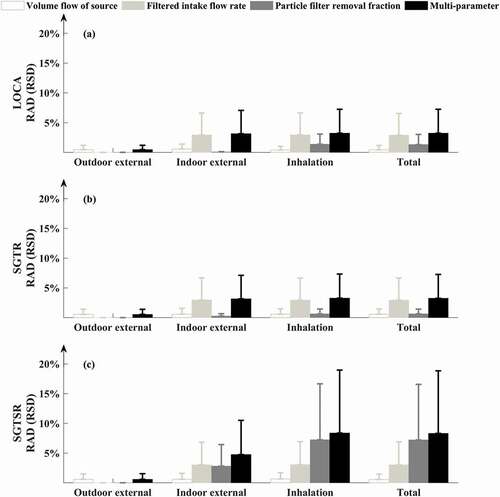
For the LOCA and SGTR, the doses are quite insensitive to the particle filter removal fraction ( and b). This is because the major radionuclides released in these two accidents are not metal radionuclides and they cannot be removed by the particle filter. However, there is a greater quantity of metal radionuclides in the SGTR than in the LOCA, and the RAD and RSD of the particle filter removal fraction in the SGTR are therefore a little larger than those in the LOCA.
For the SGTSR (), the sensitivity of the inhalation dose to the particle filter removal fraction is highest among the three accidents, with the RAD being 8.32% and the RSD being 10.5%. This result is due to the large proportion of metal radionuclides in the source term. Such high sensitivity suggests that the reliability of the particle filter is important in ensuring the radiological habitability of the CR in an accident where metal radionuclides dominate the source term.
The dependence of the inhalation dose on the particle filter removal fraction is therefore investigated separately in for the SGTSR. With a zero removal fraction, the maximum inhalation dose reaches 2.82 mSv. The inhalation dose decreases exponentially as the removal fraction increases. When the removal fraction exceeds 0.6, the decrease in the inhalation dose significantly slows. A removal fraction in the range 0.4–0.6 thus ensures a low dose.
The results of multi-parameter analysis also confirm that the filtered intake flow rate is the main contributor to the uncertainties for the total dose and for all pathways except the outdoor external pathway.
4.2.2. Cumulative probability analyses
displays the probability distribution of the body dose estimates in the multi-parameter sensitivity analysis for each pathway.
For the outdoor external dose, the mean of the estimate samples is 7.56E−4 mSv, which is within 0.881% bias from the unperturbed dose (7.49E−4 mSv, indicated by the vertical dotted line in ). All samples are within 5% deviation from the unperturbed dose. The bias in the results is therefore limited. With respect to the cumulative probability, the 95-percentile dose is 7.64E−4 mSv, which indicates that the outdoor external dose is low even in the case that uncertainties exist in multiple parameters.
For the indoor external dose, the mean of the estimate samples is 2.24E−4 mSv, which is within 3.23% bias from the unperturbed dose (2.17E−4 mSv). Ninety-five percent of samples are within 10% deviation from the unperturbed dose, while 66% of samples are within 5% deviation from the unperturbed dose. Compared with bias in the outdoor external dose, the bias in the indoor external dose is considerably higher owing to uncertainties in two more parameters. The cumulative probability shows that the 95-percentile dose is 2.38E−4 mSv, which is lower than that of the outdoor external dose.
For the inhalation dose, the mean of the estimate samples is 1.81E−1 mSv, which is within 5.76% bias from the unperturbed dose (1.71E−1 mSv). Seventy percent of the samples are within 10% deviation from the unperturbed dose, while 38% of the samples are within 5% deviation from the unperturbed dose. As for the cumulative probability, the 95-percentile dose is 1.98E−1 mSv, which is only slightly higher than the unperturbed dose.
The sensitivities of the total dose to multiple parameters are similar to those of the inhalation dose.
The 100-percentile is far below the 50-mSv limit of Chinese regulations, indicating that the radiological habitability of the HTR-PM’s CR can be guaranteed even in the presence of multiple uncertainties in the input parameters. However, radiological habitability is just one of many requirements for the CR design. According to Chinese standards [Citation20], it is necessary to consider the countermeasures for toxic gases, fire hazards and unauthorized intrusion as well, which is beyond the scope of this study.
5. Conclusions
The present study assessed the CRH of HTR-PM based on 1-year meteorological observations of the Shidao Bay nuclear power site and the latest parameters of the HTR-PM project. Body, thyroid and skin doses of three different pathways were considered and the sensitivities of the assessment to various parameters were investigated. The results demonstrated that the dose of the SGTSR was highest and the total doses of the body (2.30E−1 mSv), thyroid (1.62 mSv) and skin (1.31E−3 mSv) all met Chinese regulations and the requirements of RG 1.195 (body: 50 mSv, thyroid and skin: 500 mSv). Inhalation was the dominant pathway of occupational exposure for body and thyroid doses, contributing more than 97.9% of the total dose. Therefore, the staff in a CR need more respiratory protection in an accident. Iodines and metal radionuclides, such as I-131, I-137, Cs-137, and Cs-134, were primary contributors to the inhalation dose, and are worthy of particular attention in the design of CRH. Sensitivity analysis revealed that the particle filter removal fraction was the most influential parameter in the SGTSR, with radionuclides having high activities and dominating the total dose. Even with perturbations in multiple parameters, the 100-percentile body dose was still far below the 50-mSv dose limit in Chinese regulations, which demonstrates that the radiological habitability of the HTR-PM’s CR can be guaranteed.
Nomenclature
| ARC | = | Atmospheric relative concentration |
| CR | = | Control room |
| CRH | = | Control room habitability |
| DCF | = | Dose conversion factors |
| HTR-PM | = | High-temperature gas-cooled reactor pebble-bed module |
| LOCA | = | Large-break loss of coolant accident |
| MCM | = | Monte Carlo Method |
| RAD | = | Relative average deviation |
| RD | = | Rupture disc |
| RSD | = | Relative standard deviation |
| SGTR | = | Steam-generator tube rupture accident |
| SGTSR | = | Steam-generator tube-sheet rupture accident |
Acknowledgement
This work is supported by the National Natural Science Foundation of China [Grant No. 11475100] and the Tsinghua University Initiative Scientific Research Program [Grant No. 20151080400].
Disclosure statement
No potential conflict of interest was reported by the authors.
References
- Murphy KG, Campe KM. Nuclear power plant control room ventilation system design for meeting general criterion 19. In: Proceedings of the 13th AEC Air Cleaning Conference; 1974 Aug 12; San Francisco (CA). Washington (DC): Atomic Energy Commission; 1975.
- Ramsdell J. Atmospheric diffusion for control room habitability assessments. Richland (WA): Pacific Northwest Lab.; 1988. (NUREG/CR-5055).
- USNRC. Atmospheric dispersion models for potential accident consequence assessments at nuclear power plants: regulatory guide 1.145. Revision l. Washington (DC): US NRC; 1982.
- Ramsdell J, Simonen C, Smyth S. Atmospheric relative concentrations in building wakes. Washington (DC): Div. of Radiation Safety and Safeguards, Nuclear Regulatory Commission. Richland (WA): Pacific Northwest Lab.; 1995.
- USNRC. Standard review plan for the review of safety analysis reports for nuclear power plants: chapter 6, engineered safety features, DRAFT Rev.3. Washington (DC): US NRC; 1996.
- Ramsdell J, Fosmire CJ. Atmospheric dispersion estimates in the vicinity of buildings. Richland (WA): Pacific Northwest Lab.; 1995. (PNL-10286).
- Walker DA, Lee DW, Miller RL. Use and application of the ARCON96 dispersion model at the Y-12 complex. 2001 American Nuclear Society (ANS) Annual Meeting; 2001.
- Liu Y, Fang S, Li H, et al. First-order and second-order sensitivity studies of ARCON96 for ground release mode. 21st International Conference on Nuclear Engineering: American Society of Mechanical Engineers; 2013 Jul 29–Aug 2; Chengdu, China.
- USNRC. Methods and assumptions for evaluating radiological consequences of design basis accidents at light-water nuclear power reactors. Regulatory Guide 1.195. Washington (DC): US Government Printing Office; 2003.
- Jeong H, Park M, Hwang W, et al. Analysis of atmospheric dispersion factors for building wakes at the Wolsung nuclear site in Korea. Radiat Prot Dosimetry. 2013;154(4):430–438.
- GB18871-2002. Basic standards for protection against ionizing radiation and for the safety of radiation sources. Beijing China: Standards Press of China; 2002, [in Chinese].
- IAEA. Generic models for use in assessing the impact of discharges of radioactive substances to the environment. Safety Reports Series No. 19. Vienna: International Atomic Energy Agency; 2001.
- Eckerman KF, Wolbarst AB, Richardson AC. Limiting values of radionuclide intake and air concentration and dose conversion factors for inhalation, submersion, and ingestion: federal guidance report no. 11. Environmental protection agency, Washington (DC): Office of Radiation Programs; Oak Ridge National Lab., TN (USA); 1988. (EPA-520/1-88-020).
- Chilton AB, Shultis JK, Faw RE. Principles of radiation shielding. 1st ed. In: Chapter 7, Special techniques in photo attenuation. Englewood Cliffs (NJ): Prentice-Hall, Inc.; 1984. p. 204.
- Zhang Z, Wu Z, Wang D, et al. Current status and technical description of Chinese 2× 250MWth HTR-PM demonstration plant. Nucl Eng Des. 2009;239(7):1212–1219.
- Wang Y, Zheng Y, Li F, et al. The water ingress mass analysis on steam generator heat-exchange tube rupture accident of high temperature gas-cooled reactor. In: 17th International Conference on Nuclear Engineering; 2009 Jul 12–16; Brussels, Belgium.
- Zhengy Y, Shi L. Characteristics of the 250MW pebble-bed modular high temperature gas-cooled reactor in depressurized loss of coolant accidents. Fourth international topical meeting on high temperature reactor technology; 2008 Sep 28–Oct 1; Washington (DC). New York: ASME; 2008.
- Fischer U, Wiese HW. Verbesserte konsistente Berechnung des nuklearen Inventars abgebrannter DWR-Brennstoffe auf der Basis von Zell-Abbrand-Verfahren mit KORIGEN. Germany: Institut fur Neutronenphysik und Reaktortechnik (INR), Projekt Wiederaufarbeitung und Abfallbehandlung; 1983. (KfK-3014).
- GB50019-2015. Design code for heating ventilation and air conditioning of industrial buildings. Beijing China: Standards Press of China; 2015, [in Chinese].
- GB/T13630-2015. Design of nuclear power plant control room. Beijing (China): Standards Press of China; 2015 [in Chinese].

